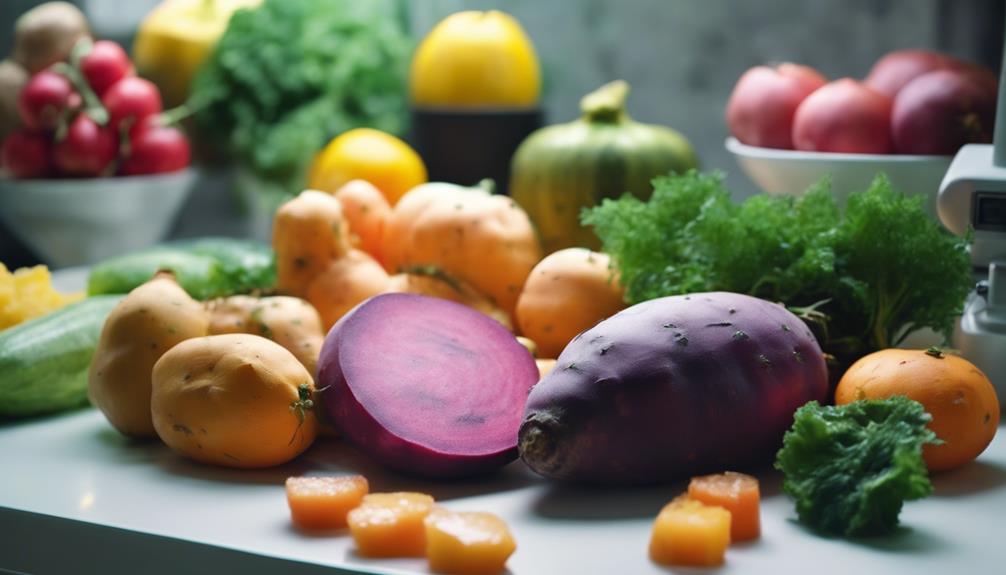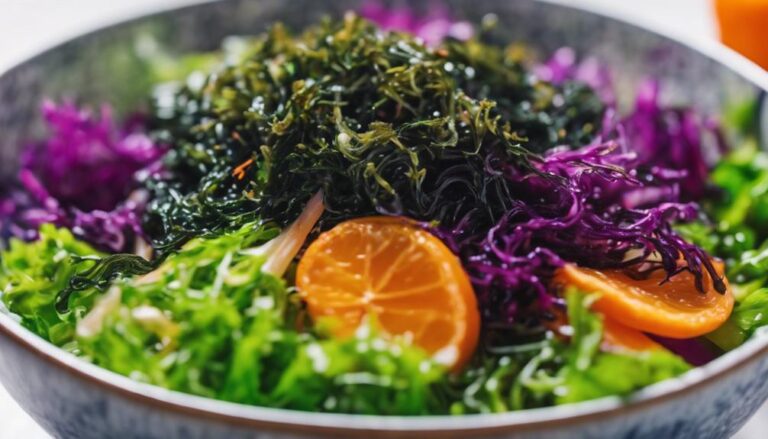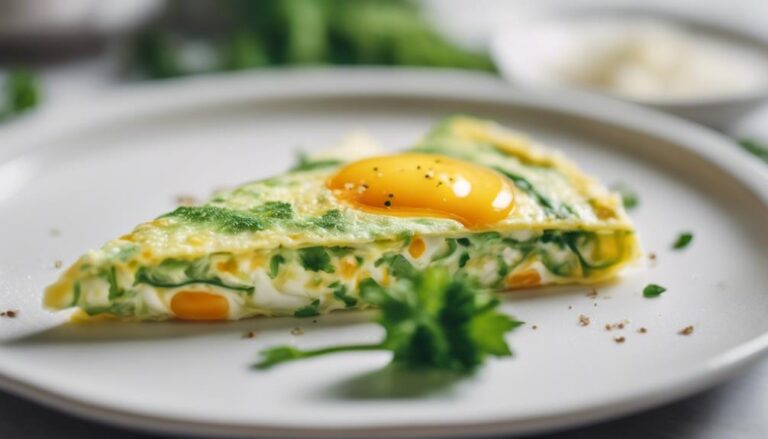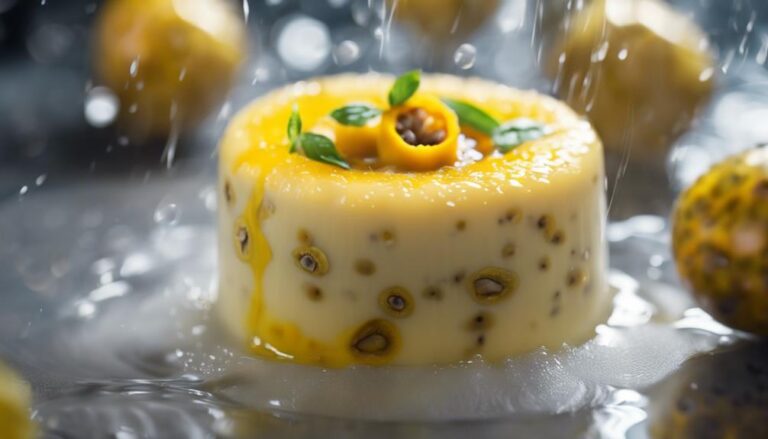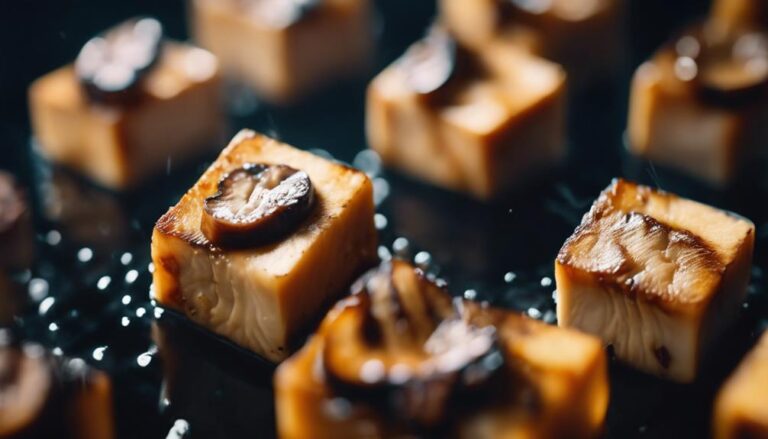Eternal Youth Recipes: Exploring the Okinawa Diet Through Sous Vide Innovation
Explore the secret to eternal youth by combining innovative sous vide techniques with the ancient Okinawa Diet. Uncover a world of rejuvenating recipes and health benefits right at your fingertips. Access the gateway to age-defying flavors and nourishment through this beautiful fusion. See how these culinary methods can transform not just your meals, but your wellbeing too. The path to everlasting vitality may just be a recipe away.
What You Will Learn Here
- Sous Vide cooking enhances Okinawan flavors and textures for a modern twist.
- Preservation of Okinawan nutrients with precise temperature control in Sous Vide.
- Modern Okinawan diet reflects changes in macronutrient composition over time.
- Sous Vide allows traditional Okinawan foods to be enjoyed with perfect results.
- Perfect texture and flavor infusion with Sous Vide for elevated Okinawan recipes.
Okinawa Diet Overview
Explore the essence of the Okinawa Diet with its traditional roots and modern adaptations. The Okinawa diet, originating from the island of Okinawa in Japan, has been associated with longevity and wellness. Traditionally, this diet focused on low-calorie, carb-rich foods like vegetables, soy products, noodles, rice, pork, and fish. However, with modernization, the diet has evolved to include more protein and fat while still maintaining its low-calorie nature.
In its original form, the Okinawa diet consisted of 85% carbohydrates, 9% protein, and 6% fat, with minimal saturated fats. Today, the distribution has shifted to 58% carbohydrates, 15% protein, and 28% fat, including slightly higher saturated fat content. This dietary shift reflects changes in food production and consumption habits over time.
Moreover, the Okinawan diet isn't just about the macronutrient composition but also incorporates the concept of food as medicine. Traditional Chinese medicine influences Okinawan cuisine, incorporating herbs and spices like turmeric and mugwort known for their health benefits. This holistic approach to food highlights the deep connection between diet and well-being.
Embracing the Okinawa diet means not only adopting a specific way of eating but also embracing a lifestyle that values physical activity and mindful eating practices. By understanding the traditional roots and modern adaptations of this diet, you can discover the secrets of health and longevity that have fascinated many.
Historical Eating Patterns
The historical eating patterns of the Okinawan people reveal a traditional diet rich in vegetables, soy products, and small amounts of noodles, rice, pork, and fish. This diet, which was low in calories and fat but high in carbohydrates, played a significant role in the exceptional longevity enjoyed by the Okinawan population. Emphasizing fresh, locally-sourced ingredients, the Okinawa diet focused on nourishing the body and promoting overall well-being.
Here is a breakdown of the macronutrient content in the original and modern Okinawa diet:
| Original | Modern | |
|---|---|---|
| Carbs | 85% | 58% |
| Protein | 9% | 15% |
| Fat | 6% (including 2% saturated fat) | 28% (including 7% saturated fat) |
As you can see, modernization and changes in dietary habits have led to a shift towards higher protein and fat intake in the Okinawa diet. Despite these alterations, the core principles of the traditional Okinawan diet, such as the emphasis on plant-based foods and mindful eating practices, continue to hold value in promoting health and longevity. Embracing these historical eating patterns can provide you with not just a meal but a holistic approach to well-being.
Modern Dietary Shifts
Incorporating innovative cooking methods like sous vide has revolutionized the traditional Okinawa diet, reflecting a shift towards modern dietary preferences. The evolution of food preparation techniques has allowed for a fusion of tradition and innovation, catering to contemporary tastes while preserving the essence of the Okinawan culinary heritage. This shift signifies a departure from strict adherence to low-calorie, carb-heavy meals towards a more balanced approach that includes increased protein and fat content.
With the advent of modernization in food production and dietary habits, the Okinawa diet has adapted to meet changing nutritional needs. While still rooted in the principles of promoting longevity and well-being, the macronutrient composition has undergone significant adjustments. The current Okinawan diet now features a higher percentage of protein and fat, reflecting a more diverse and flexible approach to eating while retaining its emphasis on wholesome, nutrient-rich foods.
Key Ingredients Explained
When delving into the Okinawa diet's key ingredients, you'll uncover a diverse array of nutrient-rich foods that form the foundation of this renowned eating style. At the core of the Okinawan cuisine are ingredients like sweet potatoes, bitter melon, tofu, seaweed, and turmeric. Sweet potatoes, a staple in the diet, provide a good source of fiber, vitamins, and minerals.
Bitter melon, known for its bitter taste, is believed to have various health benefits including blood sugar regulation. Tofu, a soy-based product, offers a plant-based protein source essential for muscle health. Seaweed, rich in iodine and antioxidants, is commonly used in Okinawan dishes for its umami flavor and nutritional benefits. Turmeric, a vibrant yellow spice, is praised for its anti-inflammatory properties and is often incorporated into Okinawan recipes.
These key ingredients not only contribute to the unique flavors of Okinawan dishes but also play an important role in promoting health and longevity. By incorporating a variety of nutrient-dense foods like these into your meals, you can embrace the essence of the Okinawa diet and potentially reap its associated benefits. Embracing these ingredients in your cooking can be a step towards a healthier lifestyle that celebrates the richness of nature's offerings.
Health Benefits Revealed
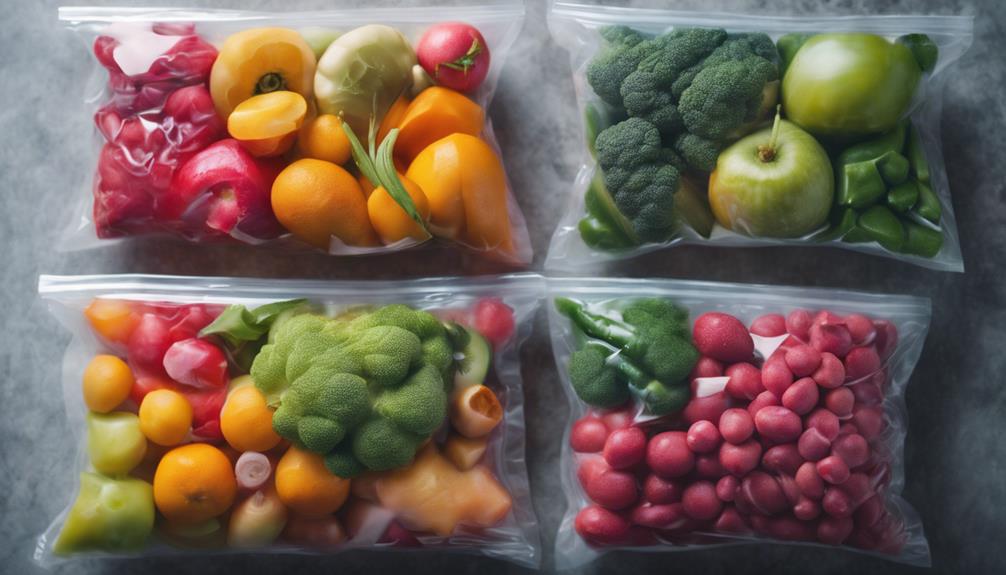
With a focus on nutrient-dense foods, the Okinawa diet offers a multitude of health benefits that can positively impact your well-being. Here are three key health benefits revealed by following the Okinawa diet:
- Longevity: By consuming a diet rich in fruits, vegetables, whole grains, and lean proteins like fish and tofu, you can potentially increase your lifespan and promote overall longevity. The Okinawans, known for their exceptional longevity, attribute much of their extended lifespan to their dietary choices.
- Heart Health: The traditional Okinawa diet is low in saturated fats and high in heart-healthy fats like omega-3 fatty acids from fish. This emphasis on healthy fats, combined with a variety of antioxidant-rich foods, can help lower cholesterol levels, reduce inflammation, and support cardiovascular health.
- Weight Management: The nutrient-dense, low-calorie nature of the Okinawa diet can aid in weight management and weight loss. By focusing on filling your plate with nutrient-rich foods that are lower in calories, you can feel satisfied while still maintaining a healthy weight. Additionally, the high fiber content of the diet can promote feelings of fullness and support digestive health.
Potential Diet Drawbacks
While the Okinawa diet offers numerous health benefits, it's important to bear in mind potential drawbacks that may arise from following this eating style. One potential concern is the strictness of the diet, which may necessitate significant discipline and may not suit everyone's lifestyle. The emphasis on low-calorie intake and specific food choices could be challenging for individuals who prefer more flexibility in their eating habits. Additionally, the traditional Okinawa diet's high carb content may not align with certain dietary preferences, such as low-carb or ketogenic diets.
Another drawback to take into account is the accessibility of ingredients required for the Okinawa diet, especially for those living outside regions where these foods are commonly found. Finding authentic Okinawan ingredients like purple sweet potatoes or bitter melon could be difficult and expensive in some areas, making it harder to fully adhere to the diet's principles.
Furthermore, the shift in the modern Okinawa diet towards higher protein and fat content may not be suitable for everyone, especially those with specific dietary restrictions or health conditions that require different macronutrient ratios. It's important to take into account individual nutritional needs and consult with a healthcare provider before making significant changes to your diet to ensure it aligns with your health goals and requirements.
Sous Vide Cooking Basics
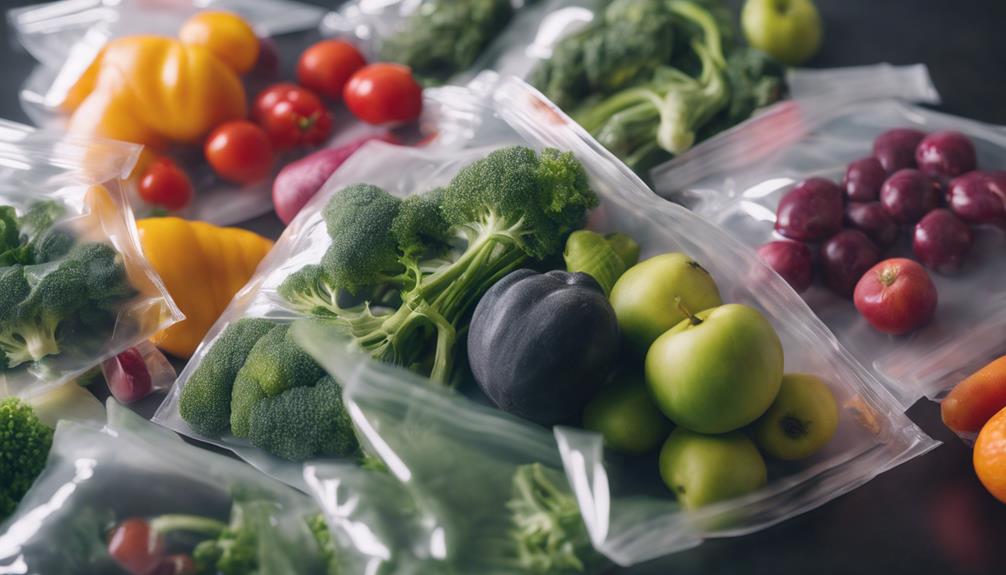
To master Sous Vide cooking, understanding the basics is important for achieving best results. Here are three key points to help you get started:
- Temperature Control: Sous Vide cooking relies on precise temperature control to cook food evenly. Make sure to set your water bath or immersion circulator to the desired temperature according to the recipe. This method ensures that your food cooks perfectly without overcooking or undercooking.
- Sealing Food: Properly sealing your ingredients in a vacuum-sealed bag is vital for Sous Vide cooking. This step helps retain the flavors and juices of the food while it cooks slowly in the water bath. Make sure that the bag is securely sealed to prevent any water from seeping in during the cooking process.
- Cooking Time: Sous Vide cooking often requires longer cooking times compared to traditional methods. It's important to follow the recommended cooking times for different types of food to achieve the desired texture and doneness. Refer to sous vide cooking guides or recipes to determine the ideal cooking time for your ingredients.
Sous Vide and Okinawan Foods
Let's explore how Sous Vide cooking can complement the flavors and textures of traditional Okinawan foods. By using Sous Vide techniques, you can enhance the natural goodness of Okinawan ingredients while preserving their nutrients. The gentle cooking method guarantees that flavors are locked in, resulting in tender and succulent dishes that celebrate the essence of Okinawan cuisine.
Here's a comparison between the original and modern breakdown of macronutrients in the Okinawa diet:
| Original | Modern | |
|---|---|---|
| Carbs | 85% | 58% |
| Protein | 9% | 15% |
| Fat | 6%, including 2% saturated fat | 28%, including 7% saturated fat |
As you can see, modernization has led to changes in the macronutrient composition of the Okinawan diet, with an increase in protein and fat content. However, by using Sous Vide cooking, you can still enjoy the health benefits associated with traditional Okinawan foods while adding a modern twist to your culinary experience. The precise temperature control of Sous Vide cooking ensures that your dishes turn out perfectly every time, allowing you to savor the flavors of Okinawa in a new and innovative way.
Recipe Innovations
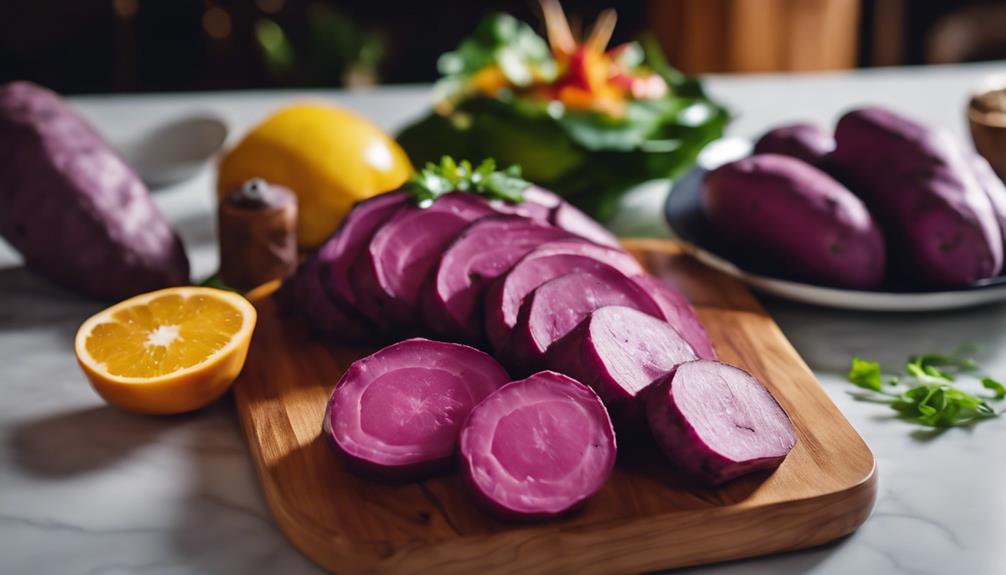
Explore how incorporating Sous Vide cooking techniques can elevate the traditional Okinawan recipes, adding a modern twist to your culinary repertoire. Using this innovative method opens up a world of flavors and textures that can breathe new life into your cooking style. Here are a few ways Sous Vide can revolutionize your Okinawan-inspired dishes:
- Enhanced Flavor Infusion:
Sous Vide allows for precise control over temperature and cooking times, ensuring that flavors are locked in. Marinate your proteins in traditional Okinawan ingredients like soy sauce, ginger, and garlic, then let the Sous Vide do its magic. The result? Juicy, tender meats bursting with umami goodness.
- Perfect Texture Every Time:
Say goodbye to overcooked or underwhelming dishes. With Sous Vide, your vegetables will be perfectly crisp yet tender, and your proteins will reach the ideal doneness without fail. Imagine enjoying a plate of perfectly cooked Okinawan sweet potatoes or a delicate piece of Sous Vide pork belly with just the right amount of melt-in-your-mouth tenderness.
- Effortless Meal Prep:
Simplify your cooking routine by prepping ingredients in advance and letting the Sous Vide do the heavy lifting. Batch-cook Okinawan favorites like tofu, bitter melon, or goya champuru, and have them ready to finish off quickly for a nutritious meal whenever hunger strikes. With Sous Vide, delicious and healthy Okinawan dishes are always within reach.
Lifestyle and Longevity Tips
Incorporating elements of the traditional Okinawan diet into your daily routine can offer valuable insights into lifestyle choices that may contribute to longevity and overall well-being. Okinawans, known for their exceptional longevity, follow a lifestyle that prioritizes balance and moderation. To emulate this, focus on maintaining an active lifestyle through regular physical activity. Engage in activities you enjoy, whether it's walking, swimming, or practicing yoga. Additionally, practice mindful eating by savoring each bite, paying attention to hunger cues, and choosing nutrient-dense foods like vegetables, fruits, and lean proteins.
Embrace the Okinawan philosophy of treating food as medicine by incorporating herbs and spices like turmeric and mugwort into your meals. These ingredients not only add flavor but also offer various health benefits. Moreover, aim to strike a balance between different food groups, emphasizing vegetables and plant-based proteins while moderating consumption of meat and processed foods.
Lastly, prioritize social connections and community engagement, as Okinawans value strong relationships and support networks. Surround yourself with positive influences, cultivate meaningful connections, and engage in activities that bring joy and fulfillment. By integrating these lifestyle and longevity tips inspired by the Okinawan tradition, you can pave the way towards a healthier and more fulfilling life.
Frequently Asked Questions
How Can I Incorporate Sous Vide Cooking Into the Okinawa Diet?
To incorporate sous vide cooking into the Okinawa diet, you can prepare lean proteins like fish and tofu with minimal added fats. Sous vide retains nutrients and flavors, enhancing your meals without compromising health benefits.
Experiment with traditional Okinawan ingredients and seasonings for a fusion of flavors. Utilize sous vide to cook vegetables to perfection while maintaining their nutritional value.
Are There Specific Sous Vide Recipes Tailored to the Okinawan Cuisine?
Are there specific sous vide recipes tailored to the Okinawan cuisine? Yes, there are!
You can explore cooking traditional Okinawan dishes like Rafute (braised pork belly) or Goya Champuru (bitter melon stir-fry) using sous vide techniques.
By infusing flavors slowly at precise temperatures, sous vide can help you recreate authentic Okinawan flavors with a modern twist.
Immerse yourself in the world of Okinawan cuisine through innovative sous vide cooking methods for a delicious culinary experience.
Can Sous Vide Cooking Help Preserve the Nutrients in Okinawan Foods?
Sous vide cooking can help preserve the nutrients in Okinawan foods. By sealing ingredients in bags and cooking them in a water bath at precise temperatures, sous vide retains more vitamins and minerals than traditional methods.
This gentle cooking technique guarantees that the nutrients stay locked in, leading to healthier and more flavorful dishes. So, if you want to maintain the goodness of Okinawan cuisine, sous vide is a fantastic choice for nutrient preservation.
What Are Some Unique Ways Sous Vide Can Enhance Traditional Okinawan Dishes?
When it comes to enhancing traditional Okinawan dishes with sous vide, you'll be amazed at the possibilities!
Sous vide can help maintain the flavors and nutrients of ingredients like pork, fish, and veggies, all staples in the Okinawa diet.
How Does Sous Vide Cooking Align With the Mindful Eating Practices of Okinawans?
Sous vide cooking aligns with Okinawans' mindful eating practices by offering precise temperature control that retains nutrients and flavors in food. This method encourages you to savor each bite, promoting a deeper connection to what you consume.
By cooking food in vacuum-sealed bags, sous vide also reduces the need for added fats or oils, staying true to Okinawa's emphasis on a low-fat diet.
Enjoy the benefits of mindful eating and nutritious meals with sous vide cooking.
Conclusion
So, are you prepared to discover the secrets of eternal youth with the Okinawa diet and sous vide cooking?
By combining ancient wisdom with modern innovation, you can create delicious and nutritious meals that promote longevity and vitality.
Embrace the health benefits of the Okinawa diet and explore new recipe innovations with sous vide technology.
Start your journey towards a healthier and longer life today!
